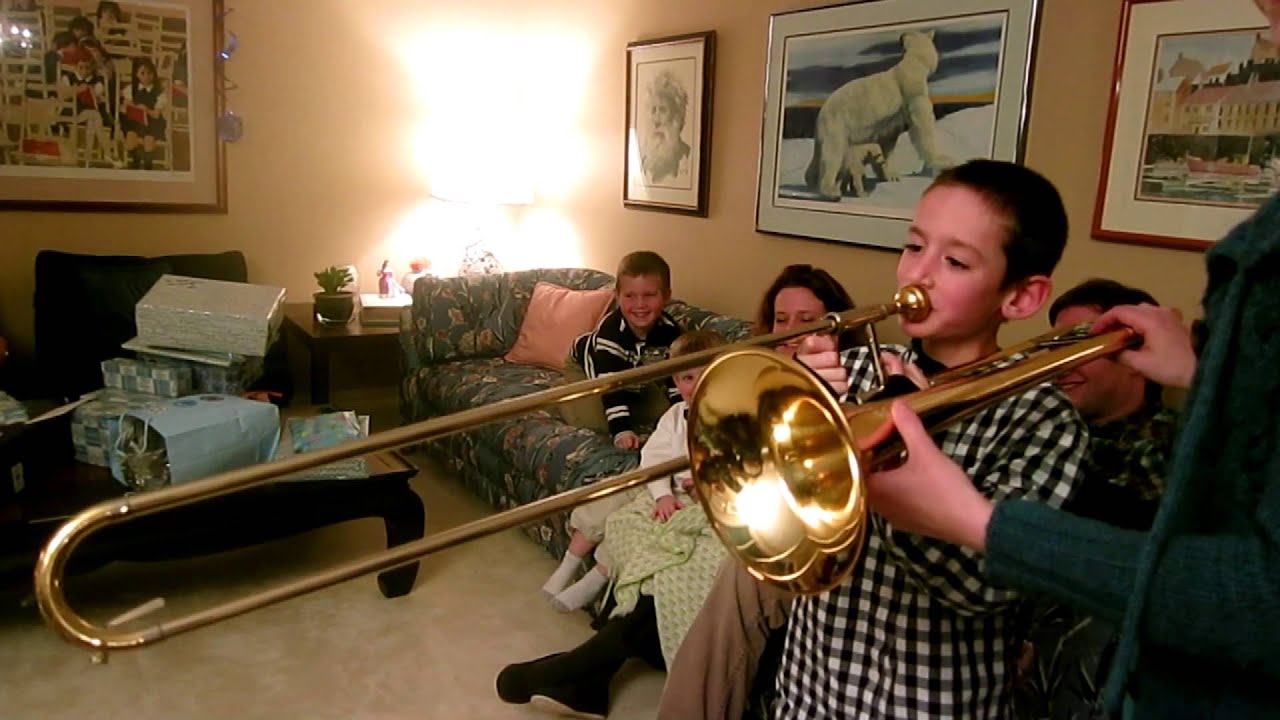Home>Production & Technology>Sound>What Does A Trombone Sound Like


Sound
What Does A Trombone Sound Like
Modified: January 22, 2024
Discover the unique and captivating sound of a trombone as it resonates through the air. Immerse yourself in the rich tones and beautiful harmonies created by this versatile instrument.
(Many of the links in this article redirect to a specific reviewed product. Your purchase of these products through affiliate links helps to generate commission for AudioLover.com, at no extra cost. Learn more)
Table of Contents
Introduction
The trombone is a unique instrument that is loved for its rich and resonant sound. With its long cylindrical tube and slide mechanism, the trombone offers a distinctively smooth and expressive tone. Whether it is soaring through the melodies of a symphony or creating soulful jazz solos, the trombone brings a dynamic and captivating sound to any musical composition.
The origins of the trombone can be traced back to ancient civilizations, with early versions of the instrument appearing in ancient Greece and Rome. Over centuries, the trombone has evolved and developed into the instrument we know today, playing a crucial role in various genres of music, from classical to jazz and beyond.
In this article, we will explore the fascinating world of the trombone’s sound. We will delve into the history of the instrument, its unique anatomy, and the mechanics behind its sound production. We will also discuss the distinct characteristics of the trombone’s sound and how they contribute to its versatility and expressive range.
Additionally, we will explore the variations in trombone sound, as different types of trombones and playing techniques can influence the sound produced. We will also highlight some of the most iconic trombone players throughout history, who have left an indelible mark on the instrument and its sound.
So, whether you are a musician, a music enthusiast, or simply curious about the wonders of sound, join us as we embark on a sonic journey to discover what a trombone truly sounds like.
History of the Trombone
The history of the trombone dates back centuries, with early versions of the instrument originating in ancient civilizations. The trombone, derived from the Italian word “tromba” (meaning trumpet) and the suffix “-one” (meaning large), was first introduced in the 15th century during the Renaissance period.
During the Renaissance, the trombone was primarily used in sacred music, adding a majestic and resonant sound to church choirs and ensembles. The instrument featured a slide mechanism, which allowed for a greater range of notes and expressive capabilities compared to other brass instruments of the time.
As music continued to evolve, so did the trombone. In the Baroque era, the instrument gained prominence in orchestras and chamber ensembles. Composers like Johann Sebastian Bach and George Frideric Handel integrated the trombone into their compositions, often utilizing its deep and sonorous sound to convey dramatic and emotional moments.
In the 19th century, the trombone underwent further advancements and modifications. The addition of valves to the instrument allowed for even greater versatility and agility. Valved trombones, known as the “valve trombone,” became popular in military bands and brass orchestras, providing a new level of technical possibilities.
By the 20th century, the trombone found its place in various genres of music, including jazz and popular music. Renowned jazz musicians such as Tommy Dorsey and J.J. Johnson showcased the trombone’s capabilities as a solo instrument, demonstrating its ability to perform intricate melodies and improvisations.
Today, the trombone continues to be a crucial component of orchestras, wind ensembles, and jazz bands. Its distinctive sound and versatility have made it a favorite among musicians and composers alike.
As the trombone’s history unfolds, its influence and significance in music remain steadfast. From its humble beginnings in ancient times to its prevalent use in contemporary music, the trombone’s journey is a testament to the enduring power of its sound.
Anatomy of a Trombone
To understand the unique sound produced by a trombone, it is essential to familiarize ourselves with the instrument’s anatomy. The trombone consists of several key components that work together to create its distinctive sound.
The main body of the trombone is a long cylindrical tube, usually made of brass. It is divided into three main sections: the bell section, the slide, and the mouthpiece.
The bell section is located at the end of the instrument and is responsible for amplifying and projecting the sound. The size and shape of the bell affect the tone and resonance of the trombone. A larger bell typically produces a deeper and fuller sound, while a smaller bell produces a brighter and more focused sound.
The slide is perhaps the most iconic feature of the trombone. It consists of two parallel tubes that can be extended or contracted using the player’s hand. By moving the slide in and out, the player can change the length of the tubing, which alters the pitch of the notes produced. This slide mechanism allows for smooth and seamless transitions between notes and provides the player with exceptional control over the instrument’s sound.
The mouthpiece is the interface between the player and the trombone. It is a small, cup-shaped attachment that is inserted into the leadpipe, which connects to the main body of the trombone. The shape and size of the mouthpiece affect the tone, projection, and playability of the instrument. Different mouthpieces can produce distinct nuances in the sound, allowing players to tailor the sound to their preferences.
Additional components of the trombone include the tuning slide and the water key. The tuning slide allows the player to adjust the overall pitch and intonation of the instrument, ensuring that it is in tune with other musicians. The water key, also known as the spit valve, is located on the lower part of the instrument and allows the player to remove condensation that accumulates during playing.
Overall, the combination of the bell, slide, mouthpiece, and other key components of the trombone contribute to its unique sound and versatility. Understanding the anatomy of the trombone is essential for players and enthusiasts to fully appreciate and explore the instrument’s capabilities.
How a Trombone Produces Sound
When a trombone is played, it produces sound through a combination of physical processes and the skillful control of the player. Understanding how these elements work together is key to comprehending the mechanics behind the trombone’s sound production.
The sound in a trombone is generated by the player buzzing their lips into the mouthpiece. As air is blown into the instrument, it vibrates the column of air inside the trombone’s tubing. The vibration of the air column creates sound waves, which then resonate and amplify within the instrument.
The shape and size of the trombone’s bell play a crucial role in shaping the sound. The bell acts as a resonator, amplifying the sound waves produced by the vibrating air column. The larger the bell, the more air it can move and the richer and fuller the sound becomes. Similarly, a smaller bell produces a more focused and brighter sound.
The slide is another essential component that contributes to the sound production. By extending or contracting the length of the slide, the player changes the effective length of the tubing. This alteration in length allows the player to produce different pitches. As the slide moves closer to the bell, the length of the tubing increases, resulting in lower pitches. Conversely, moving the slide closer to the player shortens the tubing, producing higher pitches.
The player’s skill in controlling the air flow and embouchure (lip position and tension) greatly influences the sound produced by the trombone. By adjusting the lip tension and position on the mouthpiece, the player can fine-tune the sound and control the volume and clarity of the notes. The airflow and embouchure also contribute to the expression and articulation of the music.
The trombone’s sound can be further modified through various techniques, such as vibrato, mute usage, and different types of articulation. Vibrato adds a subtle wavering effect to the sound, while mutes alter the timbre by partially blocking the bell. Articulation techniques, such as tonguing and legato playing, add varying degrees of separation or smoothness between notes.
By understanding these principles, players can master the intricacies of sound production on the trombone. Through precise control of the embouchure, airflow, slide positions, and techniques, a skilled trombonist can produce a wide range of tones and dynamics, bringing life and expression to the music they play.
Characteristics of the Trombone’s Sound
The trombone possesses several distinct characteristics that contribute to its unique sound. Understanding these characteristics can help listeners and players appreciate and identify the trombone’s signature sound.
One of the defining characteristics of the trombone’s sound is its rich and resonant tone. The cylindrical shape of the instrument’s tubing, coupled with the large bell, allows for a warm and full-bodied sound. This quality makes the trombone well-suited for playing melodies, harmonies, and solos that require depth and expressiveness.
Another notable characteristic of the trombone is its versatility. The trombone has a wide dynamic range, ranging from soft and delicate whispers to powerful and piercing blasts. This versatility allows musicians to adapt the sound of the trombone to various musical genres, from the delicate nuances of classical music to the bold and energetic nature of jazz and rock.
The slide mechanism in the trombone contributes to its characteristic glissando effect. Unlike other brass instruments that rely on valves for changing pitches, the trombone achieves smooth and seamless transitions between notes by moving the slide. This unique ability to slide between pitches gives the trombone a distinctive fluidity and flexibility, making it perfect for expressive phrasing and melodic slides.
The trombone also has exceptional agility and responsiveness. Skilled players can execute rapid passages and articulate complex rhythms with precision and clarity. This agility allows the trombone to shine in fast-paced and virtuosic musical passages, establishing it as a crucial instrument in orchestral, chamber, and jazz ensembles alike.
The trombone’s sound is also characterized by its ability to blend and complement other instruments. Its mellow timbre and wide range of dynamics make it an ideal instrument for blending harmonically with other brass, woodwind, and string instruments, enhancing the overall depth and richness of an ensemble’s sound.
Lastly, the trombone exhibits a distinctive brassy sound. This bright and metallic quality arises from the instrument’s material, primarily brass. This brassy sound adds a unique flavor to the trombone’s character, allowing it to stand out as a prominent voice within an ensemble or as a featured solo instrument.
Through its rich and resonant tone, versatility, fluidity, agility, blending capabilities, and brassy character, the trombone’s sound has captivated audiences for centuries. Its unique qualities make it a beloved and essential instrument in a wide range of musical genres, contributing to the vibrancy and diversity of the musical landscape.
Variations in Trombone Sound
While the trombone possesses a distinct sound, there are variations in tone and timbre that depend on factors such as the type of trombone, playing technique, and the musician’s stylistic choices. These variations contribute to the versatility and range of expressions achievable on the instrument.
One significant factor that affects the sound of the trombone is the type of trombone itself. The most commonly known trombone is the tenor trombone, which produces a warm and rich sound with a broad range. However, there are other types of trombones, including the alto and bass trombones.
The alto trombone, smaller in size than the tenor trombone, produces a brighter and more focused sound. It is often used in orchestral settings to showcase higher register melodies. On the other hand, the bass trombone, larger in size, produces a deeper and more resonant sound, making it suitable for lower register passages and bass lines.
Another variation in trombone sound is influenced by the player’s technique and artistic choices. Vibrato, for example, can be applied to add a subtle wavering effect to the sound, enhancing expressiveness. Skilled players may vary the intensity and speed of vibrato to create different shades of emotion and musical expression.
The use of mutes is another technique that alters the timbre and character of the trombone sound. Mutes are inserted into the bell of the trombone, modifying the resonance and color of the sound. Different types of mutes, such as the straight mute, cup mute, or bucket mute, produce distinct effects, enabling the musician to create a wide range of tonal colors and textures.
The playing technique also plays a significant role in the variations of trombone sound. The articulation, attack, and release of each note can be executed in different ways, producing variations in clarity, expression, and intensity. Additionally, the speed and precision in executing fast passages or technical runs can add unique nuances and flavors to the overall sound.
Stylistic choices also contribute to the variations in trombone sound. Depending on the genre and musical period, the sound produced may differ. In classical music, for instance, the trombone sound is characterized by its warm and blended qualities when playing in orchestras or chamber ensembles. In contrast, jazz trombonists may employ techniques such as growling, smearing, or using flutter-tonguing to achieve a more expressive and distinctive sound.
Ultimately, the variations in trombone sound allow for a vast range of expressions and interpretations. Whether it’s the type of trombone being played, the technique employed by the musician, or the artistic choices made, these variations contribute to the instrument’s versatility and its ability to adapt to different musical contexts and genres.
Famous Trombone Players
Throughout history, numerous trombone players have made a significant impact on the instrument and its sound. Their virtuosity, musicality, and contributions have helped shape the way the trombone is perceived and played in various musical genres. Here are a few notable trombone players:
- Joseph Alessi: Recognized as one of the world’s leading trombonists, Joseph Alessi has had an illustrious career as the principal trombonist of the New York Philharmonic. Known for his flawless technique and expressive playing, Alessi has also performed as a soloist, showcasing the full range of the trombone’s capabilities.
- J.J. Johnson: Considered one of the most influential trombonists in jazz, J.J. Johnson revolutionized the role of the trombone as a solo instrument in bebop and beyond. His improvisational skills, technique, and melodic interpretations set a new standard for jazz trombone playing.
- Christian Lindberg: Swedish trombonist Christian Lindberg is renowned for his versatility and virtuosity. He has expanded the boundaries of the trombone’s repertoire through his performances, compositions, and collaborations with contemporary composers. Lindberg’s innovative style and showmanship have captivated audiences worldwide.
- Tommy Dorsey: Known as “The Sentimental Gentleman of Swing,” Tommy Dorsey was a influential trombonist and bandleader during the Big Band era. His lyrical and smooth playing style made him one of the most popular trombone players of his time.
- Urbie Green: Urbie Green was a highly regarded jazz trombonist known for his technical prowess and melodic improvisations. He had a long and successful career, performing with notable artists and leaving a lasting impact on the world of jazz trombone playing.
These are just a few examples of the many trombone players who have made their mark on the instrument’s history. Each has contributed to the advancement of trombone technique, repertoire, and sound, inspiring generations of trombonists to explore the instrument’s vast potential.
Whether in classical music, jazz, or other genres, these famous trombone players have not only showcased their exceptional talent but also helped elevate the trombone to new heights of artistic expression. Their contributions continue to shape and influence the sound and perception of the trombone in the world of music.
Conclusion
The trombone’s sound is a captivating and integral part of the musical landscape. Its rich and resonant tone, versatility, and unique characteristics have made it a beloved instrument in various genres and musical settings. Understanding the trombone’s history, anatomy, sound production, and variations is key to appreciating its distinctive voice.
From its origins in ancient civilizations to its evolution through the Renaissance, Baroque, and beyond, the trombone has continuously evolved and adapted. Its unique anatomy, including the bell, slide, and mouthpiece, enables musicians to manipulate and shape the sound with precision and expressive control.
The trombone’s sound is the result of the player’s skillful combination of embouchure, airflow, slide position, and playing techniques. The instrument’s warm and resonant tone, agility, and ability to blend with other instruments make it a versatile choice for musicians across different genres.
Variations in trombone sound, whether due to different types of trombones, playing techniques, or stylistic choices, add depth and dimension to its sonic palette. From vibrato to mutes, trombone players can explore a wide range of tonal colors and textures, enhancing the instrument’s expressive capabilities.
Famous trombone players have left their indelible marks on the instrument, pushing the boundaries of technique and artistry. Their contributions have elevated the trombone’s status, inspiring current and future generations of trombonists to strive for excellence.
In conclusion, the trombone’s sound captivates with its rich tones, versatility, and expressive abilities. As a vital member of orchestras, wind ensembles, jazz bands, and various musical settings, the trombone continues to enchant listeners and convey emotions through its powerful and resonant voice. Its longstanding history and continued evolution make it a cherished instrument, cherished by musicians and appreciated by audiences worldwide.











